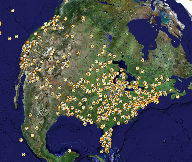3dTracking.net turns the live tracking of somebody using Maps or Earth into the seamless web 2.0 mashup experience for the masses that it should be, rather than an exploit for geeks to boast about. You, the “trackee”, will need a GPS, PDA (running Java/Symbian or Windows Mobile 5) and a connection to the net, perhaps via your mobile phone, or a hybrid of all three. Palm OS support is coming. (It also helps if your “tracker” has a Mac or PC running Google Earth somewhere, or else there isn’t much point:-)
The site promises that this will stay a free service, comes nicely packaged, and doesn’t even bother asking for your email address when you register – how enlightened is that? Premium services are in the works, presumably to allow you to see more than just the last 20 tracking positions.
I’m still waiting for somebody to track their transatlantic flight live using, for example, SAS’s in-flight wifi. If nobody does this soon I might be forced to buy myself a GPS unit:-)
[Update 23.43 UTC: A positive review from somebody who’s actually used it.]
[Update 2006-01-19: Modded up from the comments, Sergio has an interesting niche blog dedicated to GPS devices. Here is his positive review of 3DTracking. I’ll be tracking his blog…]
